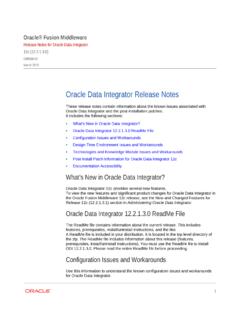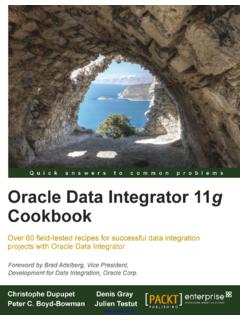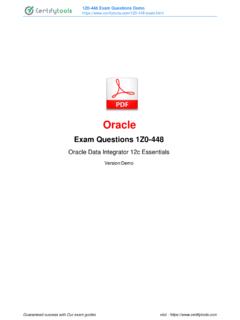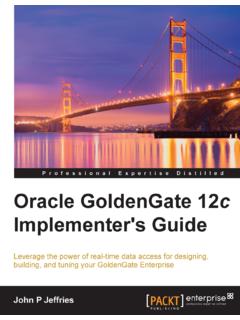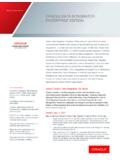Transcription of Automatic promotion and versioning with Oracle Data ...
1 Automatic promotion and versioning with Oracle data integrator 12c J r me FRAN OISSE. Rittman Mead United Kingdom Keywords: Oracle data integrator , ODI, Lifecycle, export, import, smart export, smart import, repositories, scenario, load plan, package, versioning , promotion , ODI Tools, ODI SDK, source control, SubVersion, Git. Introduction Oracle data integrator 12c is a great enterprise tool providing the ability to work efficiently on different environments. It might be the traditional architecture with Development, Test and Production environments but there are also a lot of other combinations. Oracle data integrator stores the metadata in repositories. When promoting code from one environment to another, this metadata needs to be copied into other repositories.
2 At the same time, it is always a good practice to keep track of every changes made by the developers to be able to restore an earlier version of the code. This can be done using the built-in versioning functionality of Oracle data integrator or using a third-party tool. This paper aims at describing the Development Lifecycle. We will review some common architectures and the different ways to promote and version the code. Repositories Oracle data integrator stores all it's metadata in repositories. The topology containing the connections to the datasources and the definition of agents and repositories , the security and the versioned objects are stored into a master repository. A master repository can have one or more work repository attached to it, where all the other metadata resides.
3 Illustration. 1: Oracle data integrator repositories. The work repository comes in two modes offered at creation time: Development repository or Execution repository. The former can store all the metadata about projects including mappings, packages, procedures, variables, sequences, knowledge modules, , models holding the data structures and the operator holding the logs of previous execution and the list of available scenarios and load plans. An execution repository can only hold metadata about the operator. It is therefore meant only to execute Scenarios and Load Plans and view the result of the execution. Development Lifecycle The typical way of developing with Oracle data integrator is to have developers working only on a Development repository, using it as the Development environment.
4 In this place, they can develop their code and test it again data populated especially for that purpose. Once they have a consistent set of objects ready to be promoted, they can generate scenarios of their objects and optionally sequence the execution into a Load Plan. These objects can be promoted to an Execution repository. Usually the Test environment or the Production environment are execution-only, to avoid developers to fix bugs in the wrong environment which would lead in out-of-sync repositories. Once the Scenarios and Load Plans have been promoted, they can be executed or scheduled and the result of their execution is stored into the same repository. Depending of the architecture and the procedures of each company, there might have more than one promotion required to reach the production environment.
5 Code reviews or Project Owner approval can also be pre-requisites for such a promotion . If a bug or a change request occurs, the developers have to modify or edit the objects back into the development repository and start a new iteration of the lifecycle. Thanks to this approach, the code currently sitting in Production can run successfully while new development iterations can take place on the same objects in the Development environment. However, once changed in the Development environment the underlying objects mappings, packages, are not reflecting the scenarios running in Production. As a scenario is a complete black-box version of an object, it is not editable. Therefore is important to always keep track of the underlying object code associated to every scenario version.
6 This is where the concepts of versioning and source control can answer our needs. Using either the out-of-the-box versioning capabilities or a third-party tool, developers can create a version of their objects every time they want to have snapshot and at least before each release. They need to keep track of which version of the object is related to which scenario version in order to be able to rollback to a certain point in time. Architecture The architecture can be simple, with two environments sharing the same master repository as illustrated in Illustration 1. While this can be efficient for a small team working with flexible infrastructure, this might not work at all in a more complex company. Typically, data integration jobs need to be validated by a testing/UAT team before making their way to Production.
7 This requires adding a new Testing environment. Another frequent requirement is to totally isolate Production from the other environments. This might be done through a firewall and this implies to have a separate master repository for the Production environment. In this case, the Logical Topology needs to be replicated to match perfectly in all environments. with this new separation, testing jobs on the Test Environment is not enough to prove that it will work on the Production environment, because an execution on a different master repository has never been done. Adding a new PreProduction environment with it's own master repository is the answer to this last issue. Having all these environments is great way to have reliable integration jobs, but it's at the expense of the flexibility.
8 If a bug is discovered in Production, going through all the steps Development, Test, PreProduction and finally Production takes a long time. To have a faster response, a Hot Fix environment can be added and linked directly on the PreProduction master repository. Finally, in order to support continuous integration and smoke testing, a last environment can be created and attached to the Development/Test master repository. Each night, all the scenarios marked as ready can be promoted from Development to this environment and some smoke testing execution can be scheduled. Thanks to this, a broken job can easily be identified and quickly reported. Illustration. 2: Enterprise-level Architecture. Every company is different in term of flexibility, process and infrastructure, so it's important to find the architecture that corresponds to its needs, from the simple one with two environments to this complex one with six environments and three master repositories.
9 promotion promotion from one environment to another is usually done by exporting objects from a repository and importing them in another one. It can be objects, such as Mappings, Packages or Procedures, to promote to another development environment. Or it can be Scenarios a fixed snapshot of the code ready for execution and Load Plans to promote to an execution environment. In the first case, Oracle data integrator provides a really useful functionality called smart export and import since the release. The smart export allows picking some objects as part of the build package and Oracle data integrator Studio will find all the dependencies to other objects and add it to the export. When importing, a dialog box appears to find a resolution for conflicts with existing objects.
10 The user can chose to keep the existing one, import the new one or merge the two together. When exporting Scenarios and Load Plans, the typical export and import are used. It is recommended to use Load Plan and Scenario Folders to organise the scenario per project and possibly per release. The agents can be updated to take the newly imported scenario's schedules into account or new schedules can be added. versioning The 11g release introduced a built-in versioning mechanism within Oracle data integrator . New version of Interfaces or Mappings, Packages, Procedures, User Functions, Variables, Sequences and Scenarios can be stored into the master repository with a comment to explain the changes made. As this is stored into the master repository, other environments attached to it can also access it.









